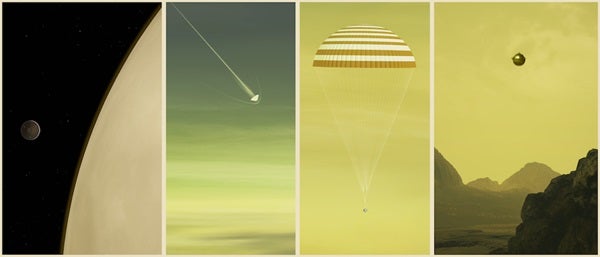Why will the DAVINCI spacecraft jettison its parachute so soon after entering Venus’ atmosphere? Won’t this result in less time to collect data and images?
Venus and its massive atmosphere present an incredibly challenging environment for any in situ probe mission. The planet’s surface temperature is approximately 860 degrees Fahrenheit (460 degrees Celsius) thanks to the dense CO2 atmosphere, which also creates a surface pressure 90 times greater than Earth at sea level.
Sulfuric acid clouds exist roughly 25 to 43 miles (40 to 70 kilometers) above the surface in a thick layer. When the DAVINCI descent sphere spacecraft (DS) jettisons its main parachute approximately 32 minutes into the descent — around 24 miles (39 km) above the surface — the temperature will already be 304 F (153 C).
This truly hellish environment presents challenges that other planetary probes don’t have to face. Trying to build a parachute that could survive these conditions would be risky and expensive. Thus, DAVINCI employs fixed drag plates to slow its descent after jettisoning the parachute. The thick venusian atmosphere also helps because the descent is more like settling into a fluid than falling through air.
It’s true that by cutting the parachute loose, the DS will spend less time in Venus’ lower atmosphere. But in many ways, this is an advantage because the craft spends less time exposed to the harsh conditions there. If the DS remained longer on the parachute, it would need to be designed to absorb more heat to keep the internal science instruments cool and have larger batteries to keep the craft operating longer through the descent. This would increase the weight, which makes it even more challenging to build a parachute to support it!
To ensure DAVINCI meets its science objectives, the DS makes use of state-of-the-art chemistry instruments and telecommunications systems that can sample the atmosphere every 500 feet (150 meters) of descent and take near-infrared images every few seconds. The DS will transmit this data to its companion craft in venusian orbit, the Carrier Relay Imaging Spacecraft (CRIS), before reaching the surface. So, in the short hour that DAVINCI will spend in Venus’ atmosphere, it will acquire groundbreaking measurements and images far beyond what any previous mission has managed.










